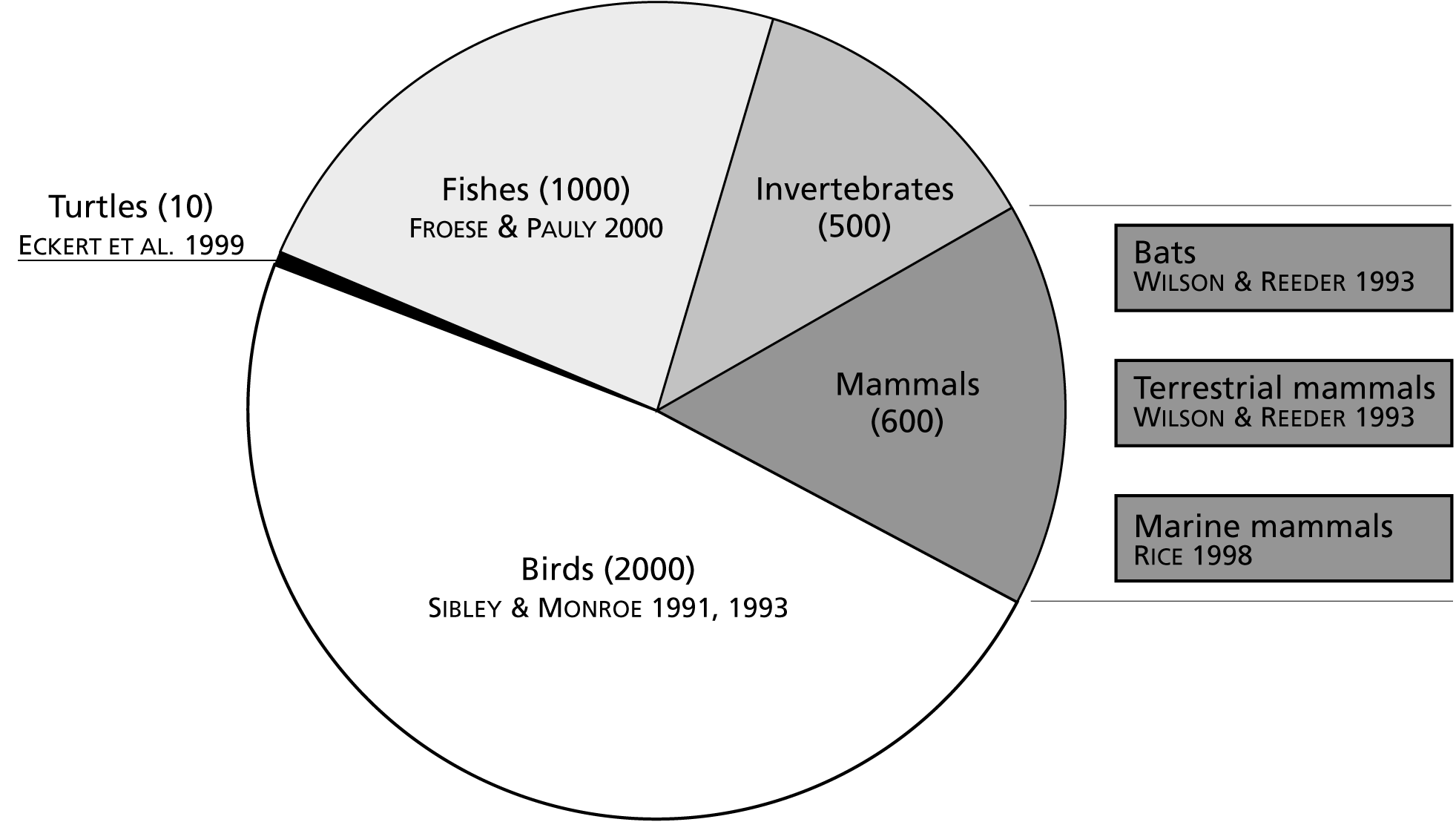
| Knowledge about migratory species | < Digital resources on biodiversity > | Protections of migratory species |
The massive development of computer technology, and in particular the Internet, has stimulated a wealth of 'biodiversity informatics' initiatives. Species names form the backbone of these information systems. Therefore, the selection of widely accepted taxonomic reference sources is crucial for effective linkage of the GROMS database to other information sources. The taxonomic catalogues used by GROMS harmonise with CMS and are widely accepted among conservationists. At present, several major initiatives are developing central species registers. These include Species20004, the Global Biodiversity Information Facility (GBIF)5, the Integrated Taxonomic Information System (ITIS)6, and the UNESCO-IOC Register of Marine Organisms (URMO)7 (cf. BISBY 2000).

| Fig. 2.1: Compilation of estimated numbers of 'true migrants' according to the GROMS definition, and taxonomic information sources. | Abb. 2.1: Geschätzte Zahl wandernder Arten nach der Definition des Weltregisters sowie taxonomische Referenzquellen. |
Databases for conservation needs have to harmonise with these initiatives, but need an additional focus on geographical distribution, threat assessment, monitoring and prioritisation. Currently, there are major conservation programs including scientific assessment run at Conservation International8, WWF-US9, BirdLife International, IUCN10, World Resources Institute11 and The Nature Conservancy12. The World Conservation Monitoring Centre (UNEP-WCMC)13 administers a huge variety of biodiversity and environmental data. It is trying to harmonise several initiatives by supporting the Biodiversity Conservation Information System (BCIS), and hosting a common website for 5 major biodiversity conventions.
With this wealth of digital information, it might be asked if the building of 'another' database for migratory species is justified. With today's developments in the sphere of distributed databases, it is possible to connect different databases via JAVA tools or Common Object Request Broker Architecture (CORBA) interfaces. There are a number of bioinformatic initiatives heading in that direction: the Australian Government's Environmental Resources Information Network (ERIN) provides combined data for an Australia-wide Geographic Information System, and the University of Kansas is developing its Species Analyst system, which maps collection sites from different museum databases, using the Z39.50 protocol (http://habanero.nhm.ukans.edu/TSA). However, considerable difficulties remain. Besides technical problems, there are unsolved questions of data custodianship and intellectual property rights. In addition, none of the mentioned databases contain substantial information about the migratory status of species, and only very few contain maps in GIS format and with the necessary time code. Therefore, GROMS was designed from scratch, but naturally profited from existing data sets and current database projects. In the future, efficient links between organismic and environmental databases will hopefully provide a more homogeneous, user-friendly information infrastructure.
| Tab. 2.2: Digital resources for migratory species | Tab. 2.2: Digitale Quellen über wandernde Arten |
| Database | Animal group | available | used in GROMS |
| African Mammal database (AMD)14 | African mammal maps | YES | YES |
| African Elephant database (AED)15 | Elephants | only printed | NO |
| Regional ringing databases | Birds, bats | on request | NO |
| Waterbird counts16 | Waterbirds | printed | partial |
| Arctic bird database7 | Arctic birds | Web | partial |
| WCMC turtle database18 | Marine turtles | YES | partial |
| FishBase (CD)19 | Fishes | YES | YES |
| Slender-billed curlew20 | Birds | on request | YES |
| 4 | Species 2000: http://www.species2000.org |
| 5 | http://www.gbif.org |
| 6 | ITIS: http://www.itis.usda.gov/ |
| 7 | URMO: http://www2.eti.uva.nl/database/urmo/backgr.html |
| 8 | http://www.conservation.org/ |
| 9 | http://www.worldwildlife.org/ |
| 10 | http://www.iucn.org |
| 11 | http://www.wri.org/wri/wri/biodiv/ |
| 12 | http://nature.org/ |
| 13 | http://www.unep-wcmc.org/ |
| 14 | Institute of Applied Ecology 1998 |
| 15 | Barnes et al. 1998 |
| 16 | Wetlands International |
| 17 | Zöckler 1998 |
| 18 | Anonymous, WCMC 1999 |
| 19 | Froese and Pauly 1998 |
| 20 | BirdLife International 2000 |
| Knowledge about migratory species | < Digital resources on biodiversity > | Protections of migratory species |
This document should be quoted as part of the publication "Riede, K. (2001): The Global Register of Migratory Species Database, GIS Maps and Threat Analysis. Münster (Landwirtschaftsverlag), 400 pp." + CD
by Klaus Riede